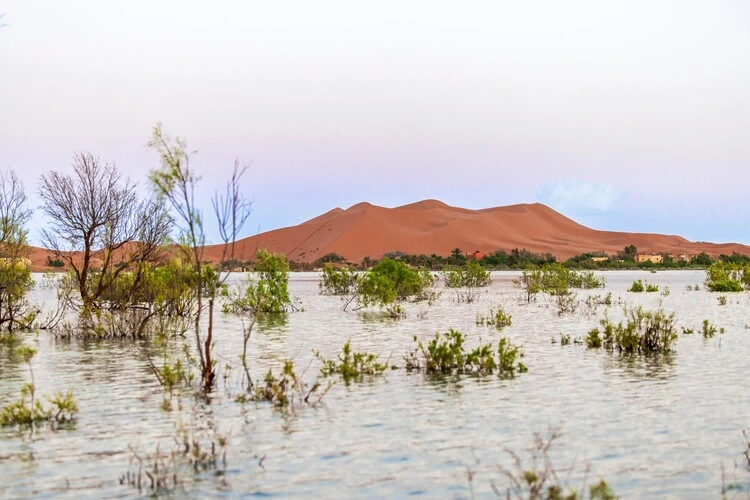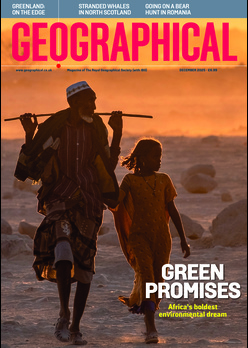
From the Sahara to northern Pakistan and Death Valley, discover more about why some of the world’s driest areas are increasingly wet
By
Out of 112 of the planet’s largest cities, more than half – 52 per cent – have become wetter across the last four decades. Some have even flipped the other way, becoming drier in the face of droughts and little rainfall. Such shifts are known as ‘climate whiplash’, meaning many locals switch from drought to deluge in the course of just a few years.
But what exactly is turning many dry places into wet ones?
Enjoying this article? Check out our related reads:
Moisture, whiplash, changing weather & ‘urban islands’
There are four main reasons to explain how dry regions are becoming wetter. One is the fact that due to climate change, the air is warmer. In turn, this means the air can hold more water vapour – around seven per cent for every 1C rise. As such, the hydrological cycle is sped up, causing more rainfall to occur. These rain events are often short and extreme, leading to flash floods rather than steady rainfall.
In addition, shifting weather patterns play a major role in rainy weather occurring. That’s because jet streams are weakening more, meaning storm systems linger for longer over certain areas. As well as this, the Intertropical Convergence Zone (ITCZ) – which drives rainfall in the tropics – is shifting due to ocean warming, moving rainfall zones across once drier areas such as the Sahel.
Climate whiplash is also having an adverse impact on dry regions. The term is used to describe sudden swings between extremes, like droughts and floods. For places including Baghdad and California, whiplash is becoming an increasingly common occurrence: dry spells punctuated by heavy rainfall.
Finally, cities in particular can face heavy rainfall due to being urban heat islands. Essentially, this term describes how cities absorb more heat – with some up to 12C hotter than nearby rural areas – and release more aerosols, a phenomenon that can trigger or worsen thunderstorms.
Below are several examples of drier places experiencing rainfall…
Death Valley
Last year, Death Valley saw intense storms that doubled its annual precipitation in several days. Lake Manly, normally a parched salt flat, re-emerged and brought kayakers to its waters. Prior to this, the park closed for several months after the storm washed away roadways and led to widespread damage.
Death Valley is usually scorching, exceeding temperatures of 43.3C in the summer with annual rainfall averaging at just two inches annually. In just six months, the region recorded almost five inches of rain.
Scientists attributed such a weather shift to a combination of El Niño – a natural warming of part of the Pacific Ocean – climate change and an atmospheric river above the region that dumped heavy rainfall.
India and Pakistan
Researchers have found that rainfall in the northwest of India and Pakistan has increased by ten to 50 per cent from 1901 to 2015, and is expected to surge by 50 to 200 per cent under moderate greenhouse gas predictions. Such weather patterns are linked to a westward expansion of the Indian summer monsoon, driven by broader shifts in the inter-tropical convergence zone and warming in the Indian Ocean.
In particular, Pakistan’s largest city – Karachi – is among the ten most at-risk of flooding from a combination of intensifying climate hazards and high vulnerability of its population. Around half of its 20-million-strong population live in slums.
To help mitigate the impact of heavy rainfall, one resident, Yasmeen Lari, has replaced asphalt surfaces with terracotta tiles – a material able to absorb rainwater – as well as installed stormwater wells in the city. During Pakistan’s 2022 floods, which impacted 33 million people, the only dry street was the one Lari had renovated.
Sahara Desert
Back in 2024, the Sahara was hit by heavy rainfall, exceeding eight inches in some places. This marked the first flood reported in the region in more than half a century. Rain filled Lake Iriqui – previously dry for 50 years – and submerged the lower half of palm trees in water.
Researchers have stressed that droughts are no longer the main threat for a desert – floods are. Increasingly common in the Sahara is the weather patterns of extreme aridity followed by intense rainstorms. Because of rising natural temperatures, the water cycle has accelerated and become more unpredictable, leading to periods in the Sahara of too much, or conversely too little, water




